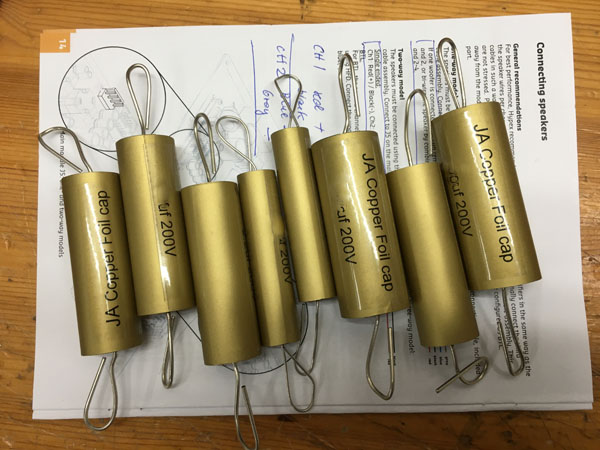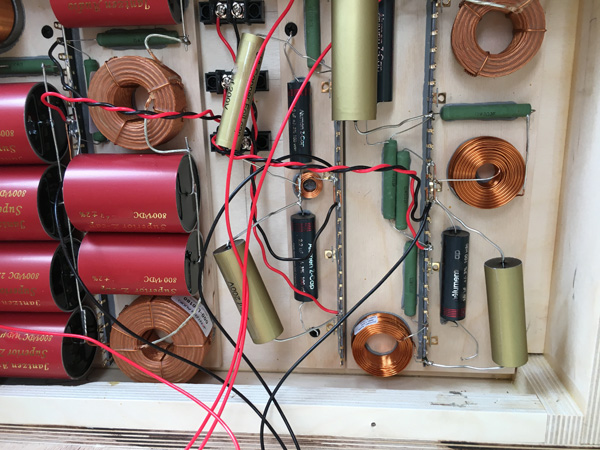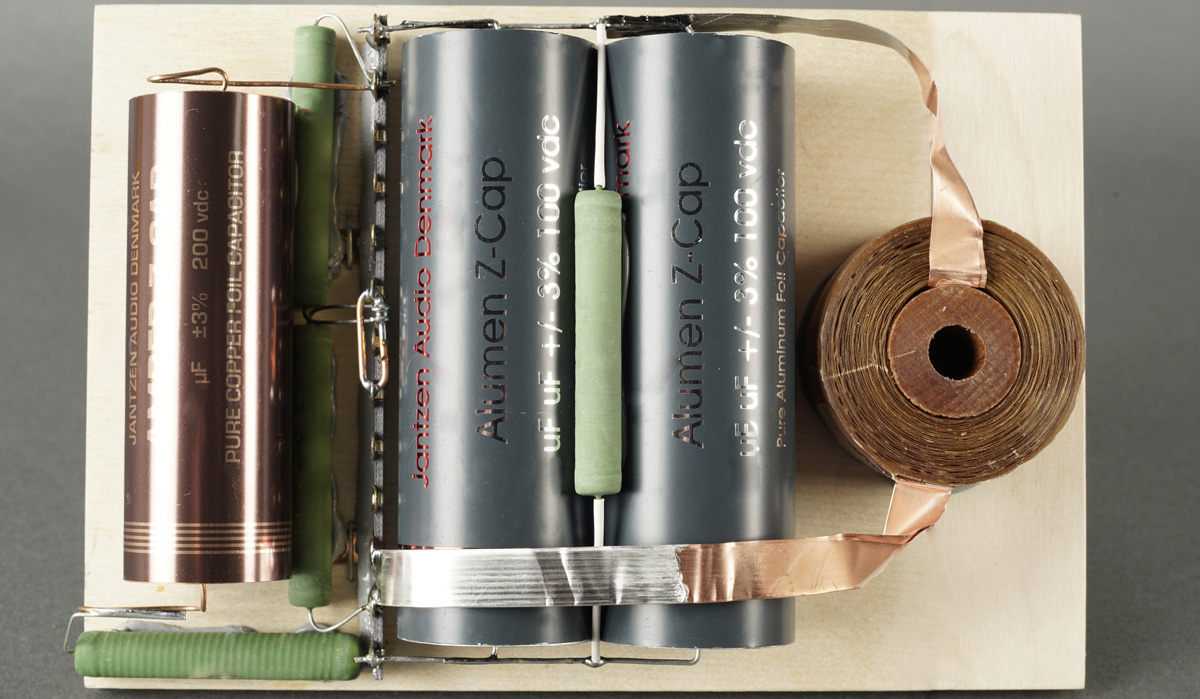AMBER-Z-CAP
Copper Foil Capacitors for
Loudspeakers
Copyright 2019 © Troels Gravesen
It is well known that some of best - and
priciest - capacitors for electronics and loudspeaker are made from pure
copper foil. Pure silver foil caps can be made - and cost a fortune and
mostly in smaller values meant for tube amps with high impedances.
In order to expand the capacitor portfolio Jantzen Audio has introduced
Amber-Z copper foil caps, especially designed for loudspeakers, having a
very thin dielectricum, polypropylene foil, allowing 200 VDC. Thinner
foil = less memory. Actually 200 V is enough for most solid state
amplifiers needing coupling caps.
The Amber-Z range goes from 1.0 uF - 8.2 uF, thus applicable for almost
all tweeter circuits and - if budget allows - also for smaller midrange
drivers asking for 15-25 uF, although not cheap.
Having had the Amber-Z for more than a year, I've used the caps in
numerous constructions during fine-tuning of crossovers - and I've
gotten addicted. We like having tools that works and tools that make us
focus on the real bottlenecks - not always having a suspicion that e.g.
this tweeter may actually be better than what I hear.
So, what can the Amber-Z do the Alumen-Z does not? Initially I had
two caps replacing the tweeter series capacitor in my
Ellipticor-4
speakers. This gave promising results and I then
asked for en entire set of capacitors for
The Loudspeaker's horn and super-tweeter section. The main horn
here, covering 1300-9000 Hz, should be the place to look for further
improvement of sound as I cannot think of any other speaker this
revealing on what's in between the music and the ear.
There are different ways of testing such devices. One is via a bunch of
switches allowing you to switch between two situations. This doesn't
work. After 5-10 minutes of switching back and forth you can't hear a damned
thing anymore unless the difference is so grave it doesn't really make
any sense.
Having listened to a system for a long time, months, the auditive memory
and your feeling of comfort can be well established and any change may be obvious in
that it tickles your perception and you have to find out how you feel
about the change. Changing all the caps in The Loudspeaker took almost
an hour before everything was in place and auditive memory isn't that
long and when having done something that holds promise of better,
then you're already preoccupied. Not easy!
As can be seen below, all caps were replaced by Amber-Z capacitors and a
wide range of musical genres were used for evaluation, primarily
acoustical recordings covering almost all acoustical instruments,
cymbals, oboe, clarinet, violin, piano, horns, tambourine, flute, etc. -
and vocals not to forget. These are the only sounds we can trust as far
as microphone quality and recording technique allows. Fortunately there
are recordings available where all things possible have been done to minimise the impact of the recording process itself, preferably
high-speed master tape to 45 rpm vinyl. Even then we can't be certain
this is as close as we can get, but it's the best we can do.
Knowledge can be a wonderful thing - and sometimes not so much.
Knowledge helps us shape and foresee the world whenever our senses feed
our brain information, a vital thing for survival, but sometimes also a hindrance for
interpretation of things we haven't experienced before. We are highly preoccupied from our past experiences;
we have to be.
Vision is the most
important of all human senses and I'm sure that were all speakers at
Munich High End Show behind curtains, we'd go home and buy differently.
Appearance plays a vital role in making our choices and if it looks good
- we may fool our brain in believing it also sounds good - and after a while
we can tell all the good stories about that product that justify our
choice.
The sheer weight and appearance of the Amber-Z oozes quality and we have
to struggle letting go of our first visual positive feelings to evaluate
the sonic quality of these caps, because sound is what
it is all about.
Is there a big difference going from Alumen-Z to Amber-Z? No. Is there a
difference at all? Yes. How much can only be determined by you.
It's a weird thing, because you kind of discover
the quality of these caps by the ease of which you listen to the music.
Assuming front-end top notch, all of a sudden you realise you're a bit
more relaxed and have to focus less because it's just there in a way it
wasn't quite before. The timbre of instruments and vocals are a bit more
natural and easy on the ear and you want to hear more and
longer, you may even play louder than before.
It can be subtle things like someone using a tiny bell, a gentle
slap of a tambourine or gentle whiskers on a drum kit - and you
suddenly realise, my goodness, this is how it should be, or at least
significantly better than heard before.
Adding percentages to quality of perceived sound - as subjective as it
is - is ludicrous - it just doesn't make sense. We can't say one
capacitor has 95% quality of another one. We're not talking break
horsepower, but a highly subjective quality that may be highly impacted by
our present mental state - and most problematic - our knowledge of what
is going on in front of us.
There may be genres of music where you would not easily recognise the difference
between Alumen-Z and Amber-Z like some electronic music or even studio
recordings of acoustic instruments, where sound may be manipulated
beyond recognition. It can be great music, absolutely, but we haven't
got a chance of knowing what the microphone picked up during the session
after all the digital processing, and the colouration of what you've
been used to hear is pleasing to your the ears. I remember one responder
dearly missing the colouration of his mediocre caps after changing to some
better grade caps. Getting rid of smear and colouration, i.e.
distortion, may take some
mental adjustments as well.
Getting the final samples of Amber-Z I replaced the series capacitor in
my
CNO-GRANDE construction and together with the modified midrange I
have the smoothest treble ever from the Crescendo tweeter.
Pooling all the Amber-Zs I have I managed to replace also the midrange
capacitors, which I shouldn't have done because now I want them to stay.
Having a very shallow 1st order filter to the W12CY003 driver, the
midrange here mingles well with the tweeter. But price would be
prohibitive and the caps would cost almost as much as the entire speaker
kit itself.
Worth the money? I think I've said this before: If you have the dough and your kids won't starve, try it out. You may love your record collection even more.
Click image or download data sheet here.


Test samples for the entire crossover for
horn and super-tweeter in
The Loudspeaker were made to evaluate performance.

Amber-Z in CNO-GRANDE crossover.